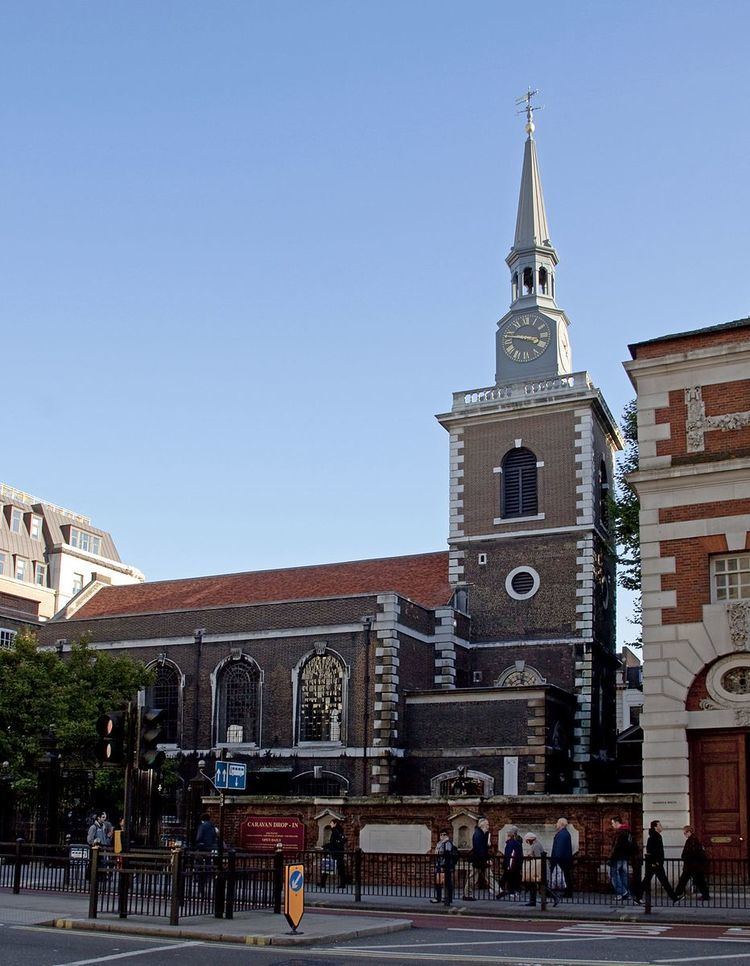Dedicated 13 July 1684 | Country England | |
 | ||
Website st-james-piccadilly.org Address 197 Picadilly, St. James's, London W1J 9LL, UK Similar St Martin‑in‑the‑Fields, St John's - Smith Square, St Paul's - Covent Garden, Wig Hall, St Mary le Strand | ||
St James's Church, Piccadilly, also known as St James's Church, Westminster, and St James-in-the-Fields, is an Anglican church on Piccadilly in the centre of London, United Kingdom. The church was designed and built by Sir Christopher Wren.
Contents
- History
- Notable baptisms
- Notable weddings
- Notable burials
- Concerts
- Outdoor art space
- Market
- Present
- References
The church is built of red brick with Portland stone dressings. Its interior has galleries on three sides supported by square pillars, and the nave has a barrel vault supported by Corinthian columns. The carved marble font and limewood reredos are both notable examples of the work of Grinling Gibbons.
History
In 1662, Henry Jermyn, 1st Earl of St Albans, was granted land for residential development on what was then the outskirts of London. He set aside land for the building of a parish church and churchyard on the south side of what is now Piccadilly. Christopher Wren was appointed the architect in 1672 and the church was consecrated on 13 July 1684 by Henry Compton, the Bishop of London. In 1685 the parish of St James was created for the church.
Samuel Clarke was rector from 1709 to 1729 and was one of the leading intellectual figures of eighteenth-century Britain. William Blake was baptised at the church in 1757. Leopold Stokowski was choirmaster from 1902 until 1905 when he left for a similar position in New York.
The church was severely damaged by enemy action in 1940, during the Second World War. Works of restoration were carried out by the architect Sir Albert Richardson. The church’s website carries a detailed history.
Notable baptisms
Notable weddings
Notable burials
Concerts
Concerts are regularly held in the church. Concerts have included performances by popular contemporary musicians such as R.E.M., the folk musician Laura Marling as part of her "church tour", the collegiate Indian-American music group Penn Masala and Devin Townsend on his 2015 UK acoustic tour.
Outdoor art space
Hauser & Wirth, a contemporary art gallery, is running a programme of outdoor sculpture exhibitions in Southwood Garden in the grounds of the church. The first exhibition was of work by the Swiss sculptor Hans Josephsohn, running from September 2009 to January 2010. Southwood Garden was created in the churchyard by Viscount Southwood after World War II as a garden of remembrance, "to commemorate the courage and fortitude of the people of London," and was opened by Queen Mary in 1946.
From 23 December 2013 to 5 January 2014 the "Bethlehem Unwrapped" demonstration against the Israeli West Bank barrier featured an art installation by Justin Butcher, Geof Thompson, and Dean Willars, which included a large replica section of the wall. The installation blocked the view of the church, other than a section of the top of the tower, which was stated by church authorities to be part of the point of the demonstration.
Market
The Piccadilly Market was established in 1981 and operates six days a week in the courtyard of St James's Church. Monday and Tuesday: Food Market, 11:00 am – 5:00 pm. Wednesday - Saturday: Arts and Craft Market, 10:00 am – 6:00 pm.
Present
Like many central London churches surrounded by commercial buildings and ever fewer local people, St James’s lost numbers and momentum in the 1960s and 1970s. When, in 1980, Donald Reeves was offered the post of rector, the bishop allegedly said "I don’t mind what you do, just keep it open." During that decade and most of the 1990s numbers and activity grew, the clergy and congregation gaining a reputation for being a progressive, liberal and campaigning church. That has continued. The "congregation" rejects that description and prefers "community". It is centred on the Eucharist, the celebration of the principal Christian sacrament. It finds expression in a wide range of interest groups: spiritual explorers, labyrinth walking, Julian prayer meetings, the Vagabonds group (a lively discussion group which takes its name from a William Blake poem and in faithfulness to that text meets in a local alehouse), a LGBT group and many others. The community has actively supported, and supports, the ordination of women to all the orders of the church, the just treatment of asylum seekers and those living in poverty. It celebrates what it regards as the "radical welcome" found in the heart of the Gospels and attested to by the Incarnation.
